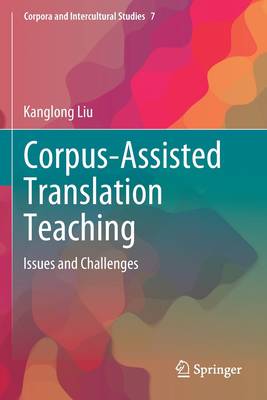
- Afhalen na 1 uur in een winkel met voorraad
- Gratis thuislevering in België vanaf € 30
- Ruim aanbod met 7 miljoen producten
- Afhalen na 1 uur in een winkel met voorraad
- Gratis thuislevering in België vanaf € 30
- Ruim aanbod met 7 miljoen producten
Zoeken
€ 183,45
+ 366 punten
Uitvoering
Omschrijving
Chapter 1 Introduction
Chapter 2 Corpus-Assisted Translation Studies2.1 Overview2.2 Types of Corpus2.2.1 Monolingual Corpora2.2.2 Comparable Corpora2.2.3 Parallel Corpora2.3 Research Areas2.3.1 Translation Universals2.3.2 Translator's Styles2.3.3 Translational Practice
Chapter 3 Corpus Use in Translation Teaching3.1 Potentials of Corpus Use in Translation Teaching3.2 Construction of Corpus3.3 DIY Corpus for translation teaching3.4 The Web as Corpus
Chapter 4 Research on Corpus-Assisted Translation Teaching4.1 Issues of Corpus Applications in Translation Teaching4.2 Research Design and other issues
Chapter 5 Web-Based Parallel Corpus in Translation Teaching5.1. Web-Based CALL and Web-Based Parallel Corpus Platform5.2. Construction of Hong Kong Parallel Chinese Corpus
CHAPTER 6 Assessing the Effects of Corpus Use in Translation Teaching6.1. Design of the Study6.2 Research Settings6.2.1. Research site6.2.2 Participants6.2.3. Nature of the Course6.3. Data Collection6.3.1. Surveys6.3.2. Translation Experiments6.3.3. Interview6.4. Data Analysis scheme
Chapter 7 Quantitative and Qualitative Analysis of the Effects of Corpus Use in Translation Teaching7.1. Quantification of the Effects7.1.1 C-E Translation Test7.1.1.1 TEM4 Scores7.1.1.2 Translation Pretest7.1.1.3 Analysis of C-E Translation Test7.1.2 E-C Translation Test7.1.2.1 TEM4 Scores7.1.2.2 Translation Pretest7.1.2.3 Analysis of E-C Translation Test7.2 Qualitative Assessment of the Effects7.2.1 Evaluation of the English Translated Texts7.2.1.1. Misspellings7.2.1.2. Word Choice7.2.1.3. Terminology7.2.1.4. Phraseology7.2.1.5. Collocations7.2.1.6. Style7.2.2 Evaluation of the Chinese Translated Texts7.2.2.1. Misspelled Chinese Words7.2.2.2. Word Choice7.2.2.3. Terminology7.2.2.4. Phraseology7.2.2.5. Collocations7.2.2.6. Style
Chapter 8 Assessing Students' Attitudes and Perceptions on Corpus Use in Translation8.1. Learners' Perception Studies8.2. Corpus Use Survey8.2.1. Survey Design and Validity8.2.2. Survey Results8.3. Focus Group Interviews8.3.1. Corpus Content and Design8.3.2. Context as a Major Advantage of Corpus8.3.3. Corpus as One of the Reference Tools for Translation8.3.4. Translation Direction8.3.5. Creativity vs. Conservatism of Corpus Use
Chapter 9 Corpus-Assisted Translation Studies: Looking Into The Future9.1 Corpus in Translation Teaching9.2 Research on Corpus Assisted Translation Teaching
BibliographyAppendix
Chapter 2 Corpus-Assisted Translation Studies2.1 Overview2.2 Types of Corpus2.2.1 Monolingual Corpora2.2.2 Comparable Corpora2.2.3 Parallel Corpora2.3 Research Areas2.3.1 Translation Universals2.3.2 Translator's Styles2.3.3 Translational Practice
Chapter 3 Corpus Use in Translation Teaching3.1 Potentials of Corpus Use in Translation Teaching3.2 Construction of Corpus3.3 DIY Corpus for translation teaching3.4 The Web as Corpus
Chapter 4 Research on Corpus-Assisted Translation Teaching4.1 Issues of Corpus Applications in Translation Teaching4.2 Research Design and other issues
Chapter 5 Web-Based Parallel Corpus in Translation Teaching5.1. Web-Based CALL and Web-Based Parallel Corpus Platform5.2. Construction of Hong Kong Parallel Chinese Corpus
CHAPTER 6 Assessing the Effects of Corpus Use in Translation Teaching6.1. Design of the Study6.2 Research Settings6.2.1. Research site6.2.2 Participants6.2.3. Nature of the Course6.3. Data Collection6.3.1. Surveys6.3.2. Translation Experiments6.3.3. Interview6.4. Data Analysis scheme
Chapter 7 Quantitative and Qualitative Analysis of the Effects of Corpus Use in Translation Teaching7.1. Quantification of the Effects7.1.1 C-E Translation Test7.1.1.1 TEM4 Scores7.1.1.2 Translation Pretest7.1.1.3 Analysis of C-E Translation Test7.1.2 E-C Translation Test7.1.2.1 TEM4 Scores7.1.2.2 Translation Pretest7.1.2.3 Analysis of E-C Translation Test7.2 Qualitative Assessment of the Effects7.2.1 Evaluation of the English Translated Texts7.2.1.1. Misspellings7.2.1.2. Word Choice7.2.1.3. Terminology7.2.1.4. Phraseology7.2.1.5. Collocations7.2.1.6. Style7.2.2 Evaluation of the Chinese Translated Texts7.2.2.1. Misspelled Chinese Words7.2.2.2. Word Choice7.2.2.3. Terminology7.2.2.4. Phraseology7.2.2.5. Collocations7.2.2.6. Style
Chapter 8 Assessing Students' Attitudes and Perceptions on Corpus Use in Translation8.1. Learners' Perception Studies8.2. Corpus Use Survey8.2.1. Survey Design and Validity8.2.2. Survey Results8.3. Focus Group Interviews8.3.1. Corpus Content and Design8.3.2. Context as a Major Advantage of Corpus8.3.3. Corpus as One of the Reference Tools for Translation8.3.4. Translation Direction8.3.5. Creativity vs. Conservatism of Corpus Use
Chapter 9 Corpus-Assisted Translation Studies: Looking Into The Future9.1 Corpus in Translation Teaching9.2 Research on Corpus Assisted Translation Teaching
BibliographyAppendix
Specificaties
Betrokkenen
- Auteur(s):
- Uitgeverij:
Inhoud
- Aantal bladzijden:
- 168
- Taal:
- Engels
- Reeks:
- Reeksnummer:
- nr. 7
Eigenschappen
- Productcode (EAN):
- 9789811589973
- Verschijningsdatum:
- 3/11/2021
- Uitvoering:
- Paperback
- Formaat:
- Trade paperback (VS)
- Afmetingen:
- 156 mm x 234 mm
- Gewicht:
- 267 g

Alleen bij Standaard Boekhandel
+ 366 punten op je klantenkaart van Standaard Boekhandel
Beoordelingen
We publiceren alleen reviews die voldoen aan de voorwaarden voor reviews. Bekijk onze voorwaarden voor reviews.








